Diane: Our friend Mikki from Chiclayo showed up today at our hotel room ready to enjoy Semana Santa with us. He will be with us for an indefinite amount of time, depending on some important life decisions he is making concerning his studies, his work, and his domicile. With Mikki here, I am excited that we will have strong motivation to continue speaking Spanish, while we are on the road. Growing up in Peru, his bargaining skills and command of Spanish come with the territory; hopefully this will diminish the number of misunderstandings we unintentionally wander into. Since Mikki is completing a degree in tourism and newly working in the tourism industry, this should be an opportunity for him to travel to parts of Peru he has not visited, to improve his English, and to increase his understanding of what lurks in the hearts and minds of foreigners traveling in Peru. I'm hoping we all benefit.
Now that Semana Santa has arrived, there are processions every day. Each procession consists of 2 or 3 floats for Jesus, Mary, and sometimes a patron saint of the church organizing the event.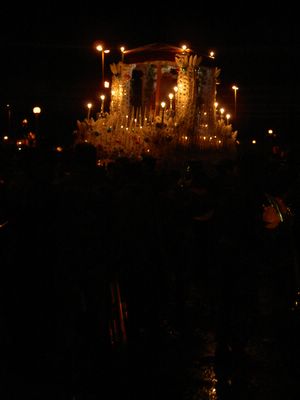
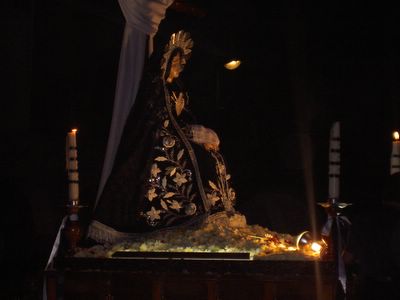
Additionally there is usally a picture of Jesus raised up high with unexpected iconography surrounding it, such as a rooster above the Christ image and a ladder to his side.
Although small, these processions clearly demonstrate the reverence and devotion of the participants. Heading up each procession are a group of people holding candles.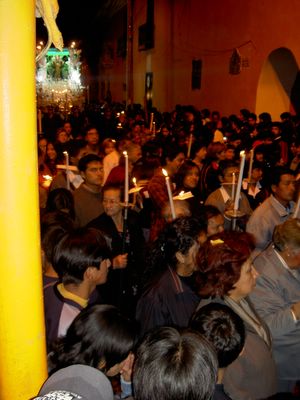
Then comes a small orchestra, followed by clergy. The floats are not based on the traditional flat-bed or pick-up truck. Instead the float rides on 4 or 5 large logs with many people supporting each log on their shoulders. It looks very heavy and cumbersome. As the float moves it sways from side to side as the weight shifts from the people on one side to those on the other.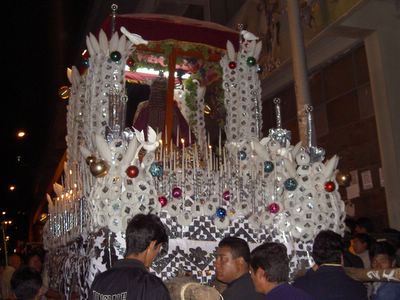
Each float is adorned with some electric candles as well as many wax candles. As the float moves, the wax candles blow out. There is usually someone relighting these candles, whenever the procession stops.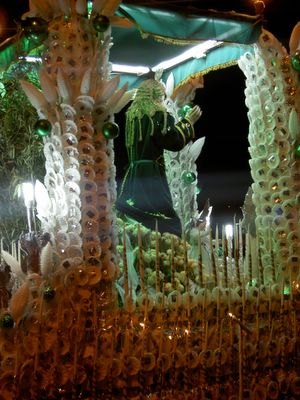
Every couple hundred feet the procession stops, the orchestra plays, and members of the clergy speak. Sometimes there will be a changing-of-the-guard, when a new contingent of helpers replaces those carrying the heavy load. Each float is generally flanked on each side by military personnel.
Following the float is an army marching band that plays as they move along.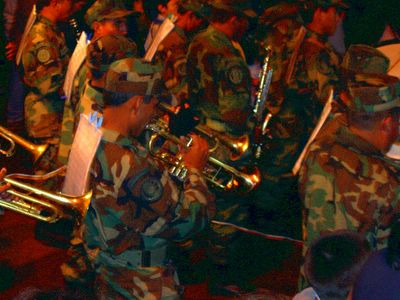
Somewhere near the musicians both in front of and behind the float are megaphones/speakers as well as someone holding out a microphone nearby. There is also a generator that powers the electric lights and the speakers. Although the generator competes with the musicians for sound space, it is possible to hear the music from various angles. People throw flowers as the procession passes. It generally takes over an hour to move around a small plaza. This provides ample opportunity to float in the sacredness of the moment. For me 15 minutes was sufficient.
Since pre-Columbian times, people here have shown their reverence through parades. They hang images from poles, small banners that showed the purpose of the procession. We have seen some of supports for similar banners, hundreds of years old, made from metal, in some of the museums we have visited. This tradition has continued to the present day and is incorporated into these nightly parades.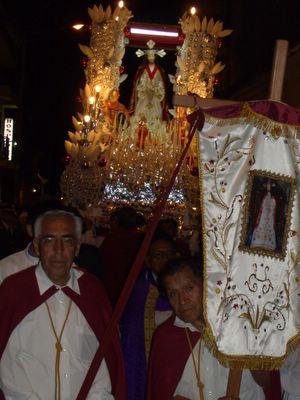
Although the processions only involved one or two floats, the elaborate decorations and ornamentation were impressive. The care and preparation time necessary to put it all together were obvious. Candles are an elegant statement in the dark of night.
There is a lot of pain here as well, from "Our Lady of Sorrow" to "Our Lord of Agony". Four to five times a day I am asked if I am Catholic. As a non-Catholic, I am most definitely an outsider here, an observer, with only a weak-to-nonexistent understanding of Christian/Catholic theology.

No comments:
Post a Comment